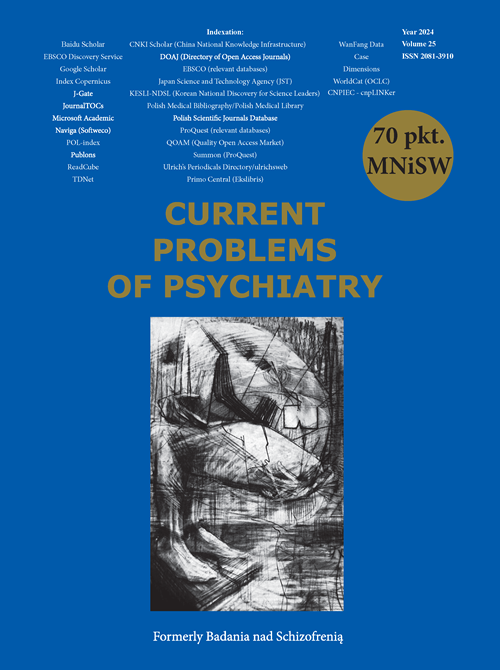Affective disorders and self-injurious behavior in children and young adults with carbohydrate metabolism disorders
DOI:
https://doi.org/10.12923/2353-8627/2024-0010Słowa kluczowe:
zaburzenia afektu, depresja, samobójstwo, cukrzyca, dzieciAbstrakt
Wstęp: Zaburzenia afektu oraz zaburzenia gospodarki węglowodanowej są problemami o rosnącym znaczeniu w populacji dzieci, nastolatków i młodych dorosłych. Wiele dowodów wskazuje na to, iż problemy te mogą ze sobą współwystępować ze zwiększoną częstością i nieść znacznie bardziej poważne konsekwencje niż osobno.
Materiał i metody: Dokonano przeglądu bazy MEDLINE zgodnie z założonymi a priori kryteriami włączenia. Zakwalifikowane badania obejmowały uczestników do 25 roku życia ze zdiagnozowanymi zaburzeniami gospodarki węglowodanowej, a metody badawcze obejmowały pomiary psychometryczne objawów zaburzeń afektu i tendencji autoagresywnych.
Dyskusja: Wyniki 10 z 12 zakwalifikowanych do przeglądu badań potwierdziły zwiększone ryzyko wystąpienia depresji i tendencji samobójczych u pacjentów z cukrzycą. W opisywanych publikacjach częstość zaburzeń afektu w określonej populacji wynosiła od 1.2% do 47.6% oraz do 60.4% dla nieokreślonego zaburzenia afektu o pełno- i niepełnoobjawowym nasileniu, a współczynnik ryzyka HR od 1.33 do 2.0 dla pełnoobjawowych zaburzeń afektu, oraz do 6.49 dla nieokreślonego zaburzenia afektu o pełno- i niepełnoobjawowym nasileniu. Opisy częstości występowania tendencji autoagresywnych i samobójczych szacują je w zakresie od 0.8% do 35.7%, a w badaniach z porównaniem do grupy kontrolnej współczynnik ryzyka dla próby samobójczej wyniósł między HR: 1.7 a 3.25.
Wnioski: Występowanie zaburzeń afektu u dzieci i młodych dorosłych jest wyraźnie częstsze w przypadku współwystępowania cukrzycy niż w przypadku braku zaburzeń gospodarki węglowodanowej.
Bibliografia
1. Racine N, McArthur BA, Cooke JE, Eirich R, Zhu J, Madigan S. Global Prevalence of Depressive and Anxiety Symptoms in Children and Adolescents During COVID-19: A Meta-analysis. JAMA Pediatr. 2021 Nov 1;175(11):1142. Review match
2. Grey M, Whittemore R, Tamborlane W. Depression in type 1 diabetes in children: natural history and correlates. J Psychosom Res. 2002 Oct;53(4):907–11. Review match
3. Ward ZJ, Yeh JM, Reddy CL, Gomber A, Ross C, Rittiphairoj T, et al. Estimating the total incidence of type 1 diabetes in children and adolescents aged 0–19 years from 1990 to 2050: a global simulation-based analysis. Lancet Diabetes Endocrinol. 2022 Dec;10(12):848–58. Review match
4. Perng W, Conway R, Mayer-Davis E, Dabelea D. Youth-Onset Type 2 Diabetes: The Epidemiology of an Awakening Epidemic. Diabetes Care. 2023 Mar 1;46(3):490–9. Review match
5. Mazze RS, Lucido D, Shamoon H. Psychological and Social Correlates of Glycemic Control. Diabetes Care. 1984 Jul 1;7(4):360–6. Review match
6. Kaminer Y, Robbins DR. Insulin misuse: a review of an overlooked psychiatric problem. Psychosomatics. 1989 Winter;30(1):19–24. Review match
7. Boileau P, Aboumrad B, Bougnères P. Recurrent comas due to secret self-administration of insulin in adolescents with type 1 diabetes. Diabetes Care. 2006 Feb;29(2):430–1. Review match
8. Butwicka A, Frisén L, Almqvist C, Zethelius B, Lichtenstein P. Risks of psychiatric disorders and suicide attempts in children and adolescents with type 1 diabetes: a population-based cohort study. Diabetes Care. 2015 Mar;38(3):453–9. Review match
9. Perry BI, Khandaker GM, Marwaha S, Thompson A, Zammit S, Singh SP, et al. Insulin resistance and obesity, and their association with depression in relatively young people: findings from a large UK birth cohort. Psychol Med. 2020 Mar;50(4):556–65. Review match
10. Sinnamon GCB, Caltabiano M, Baune BT. Differentiating disordered affect in children and adolescents with type 1 diabetes. J Affect Disord. 2013 May;147(1–3):51–8. Review match
11. Helgeson VS, Snyder PR, Escobar O, Siminerio L, Becker D. Comparison of adolescents with and without diabetes on indices of psychosocial functioning for three years. J Pediatr Psychol. 2007 Aug;32(7):794–806. Review match
12. Efe YS, Erdem E. A Comparison of Aggression and Self-injury Among Type 1 Diabetic and Healthy Adolescents: A Sample From Turkey. Arch Psychiatr Nurs. 2018 Apr;32(2):174–9. Review match
13. Vila G, Robert JJ, Nollet-Clemencon C, Vera L, Crosnier H, Rault G, et al. Eating and emotional disorders in adolescent obese girls with insulin-dependent diabetes mellitus. Eur Child Adolesc Psychiatry. 1995 Oct;4(4):270–9. Review match
14. Kovacs M, Goldston D, Obrosky DS, Bonar LK. Psychiatric disorders in youths with IDDM: rates and risk factors. Diabetes Care. 1997 Jan;20(1):36–44. Review match
15. Robinson ME, Simard M, Larocque I, Shah J, Nakhla M, Rahme E. Risk of Psychiatric Disorders and Suicide Attempts in Emerging Adults With Diabetes. Diabetes Care. 2020 Feb;43(2):484–6. Review match
16. Roberts AJ, Bao H, Qu P, Moss A, Kim G, Yi-Frazier JP, et al. Mental health comorbidities in adolescents and young adults with type 2 diabetes. J Pediatr Nurs. 2021 Dec;61:280–3. Review match
17. Radobuljac MD, Bratina NU, Battelino T, Tomori M. Lifetime prevalence of suicidal and self-injurious behaviors in a representative cohort of Slovenian adolescents with type 1 diabetes. Pediatr Diabetes. 2009 Nov;10(7):424–31. Review match
18. Cooper MN, de Klerk NH, Jones TW, Davis EA. Clinical and demographic risk factors associated with mortality during early adulthood in a population-based cohort of childhood-onset type 1 diabetes. Diabet Med J Br Diabet Assoc. 2014 Dec;31(12):1550–8. Review match
19. Majidi S, O’Donnell HK, Stanek K, Youngkin E, Gomer T, Driscoll KA. Suicide Risk Assessment in Youth and Young Adults With Type 1 Diabetes. Diabetes Care. 2020 Feb;43(2):343–8. Review match
20. Buchberger B, Huppertz H, Krabbe L, Lux B, Mattivi JT, Siafarikas A. Symptoms of depression and anxiety in youth with type 1 diabetes: A systematic review and meta-analysis. Psychoneuroendocrinology. 2016 Aug;70:70–84. Review match
21. Zhang J, Sun R, Cai Y, Peng B, Yang X, Gao K. Efficacy and Safety of Antidiabetic Agents for Major Depressive Disorder and Bipolar Depression: A Meta-Analysis of Randomized, Double-Blind, Placebo-Controlled Trials. J Clin Med. 2024 Jan;13(4):1172.
Pobrania
Opublikowane
Numer
Dział
Licencja
Prawa autorskie (c) 2024 Autorzy

Utwór dostępny jest na licencji Creative Commons Uznanie autorstwa 4.0 Międzynarodowe.


